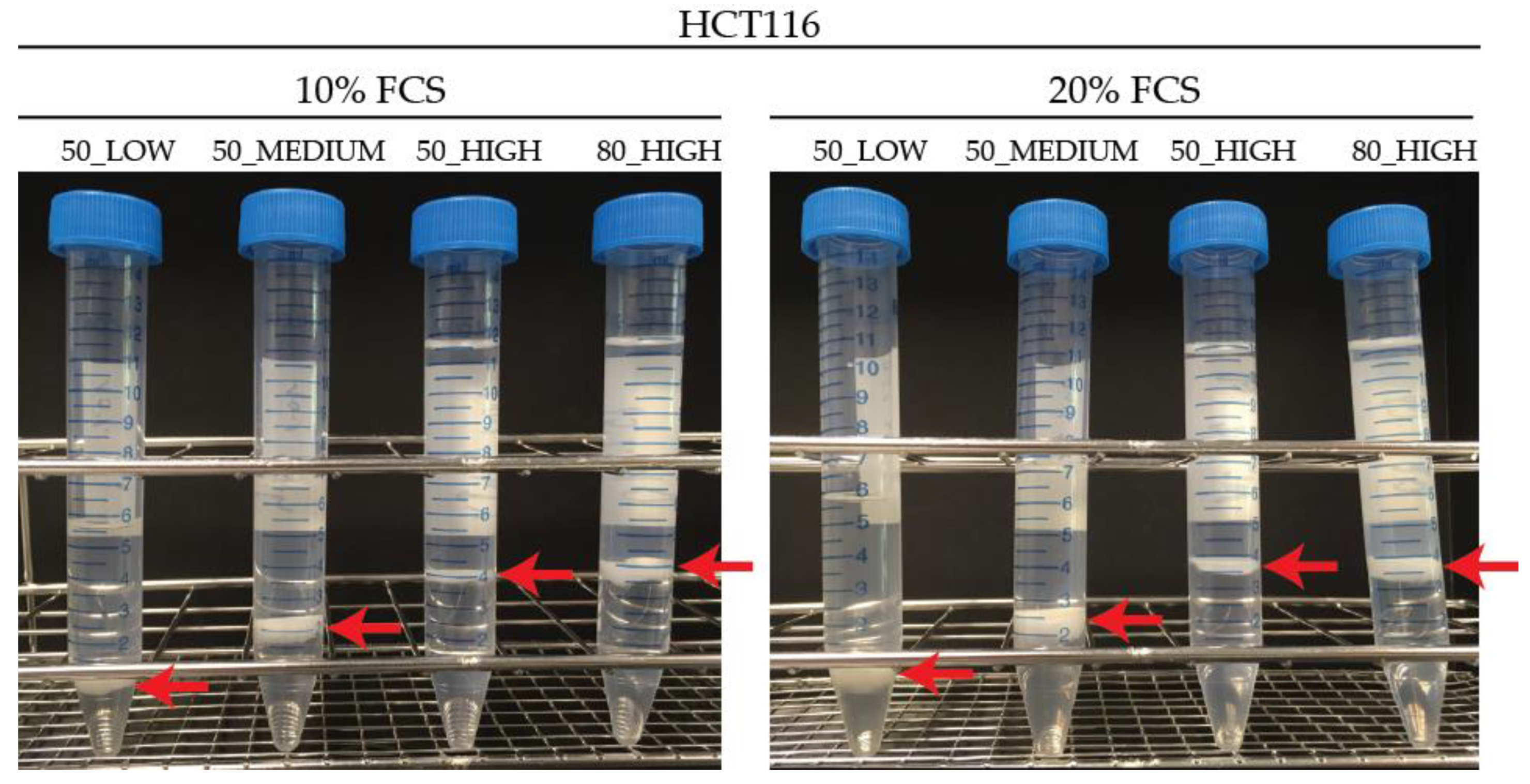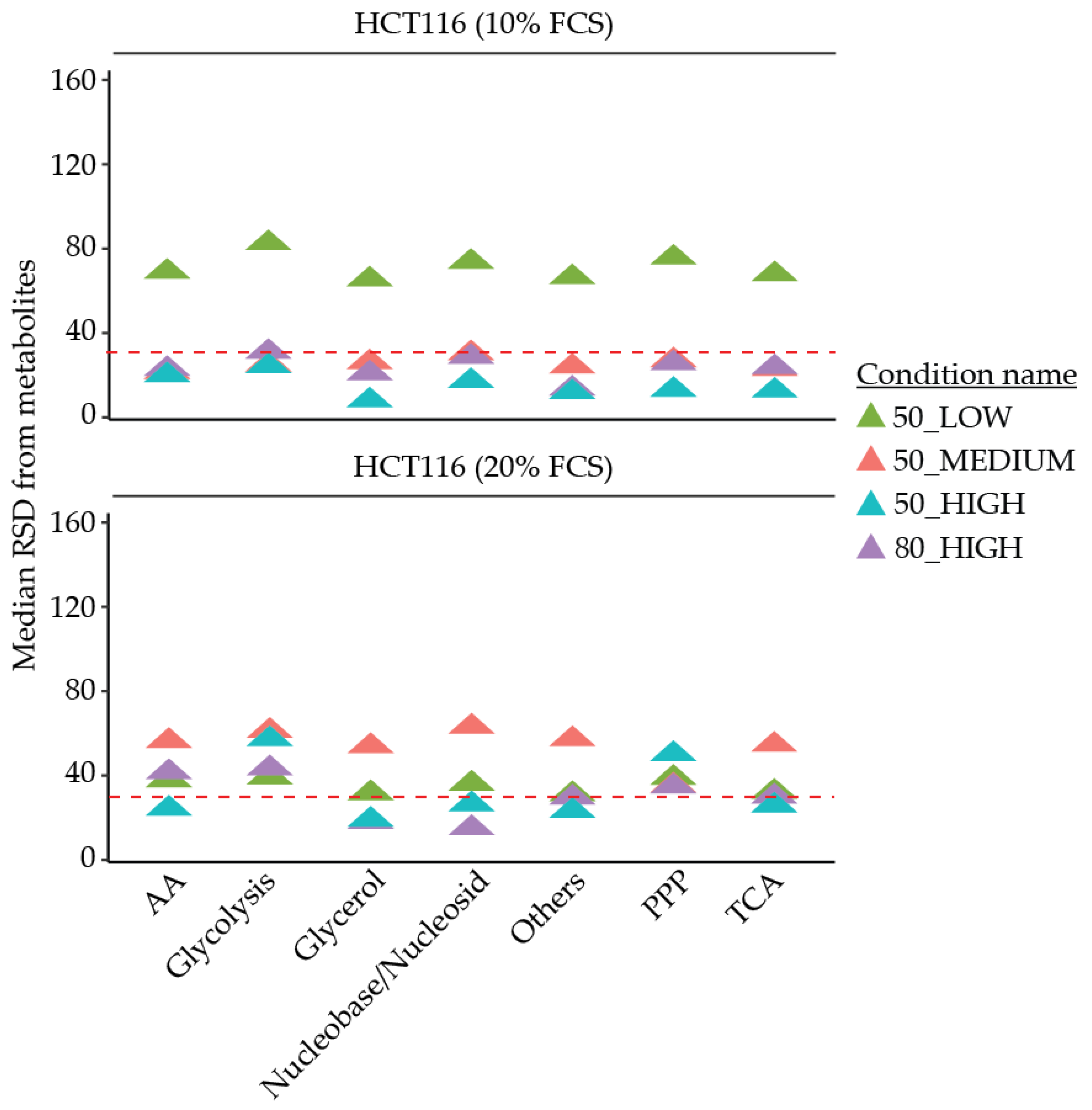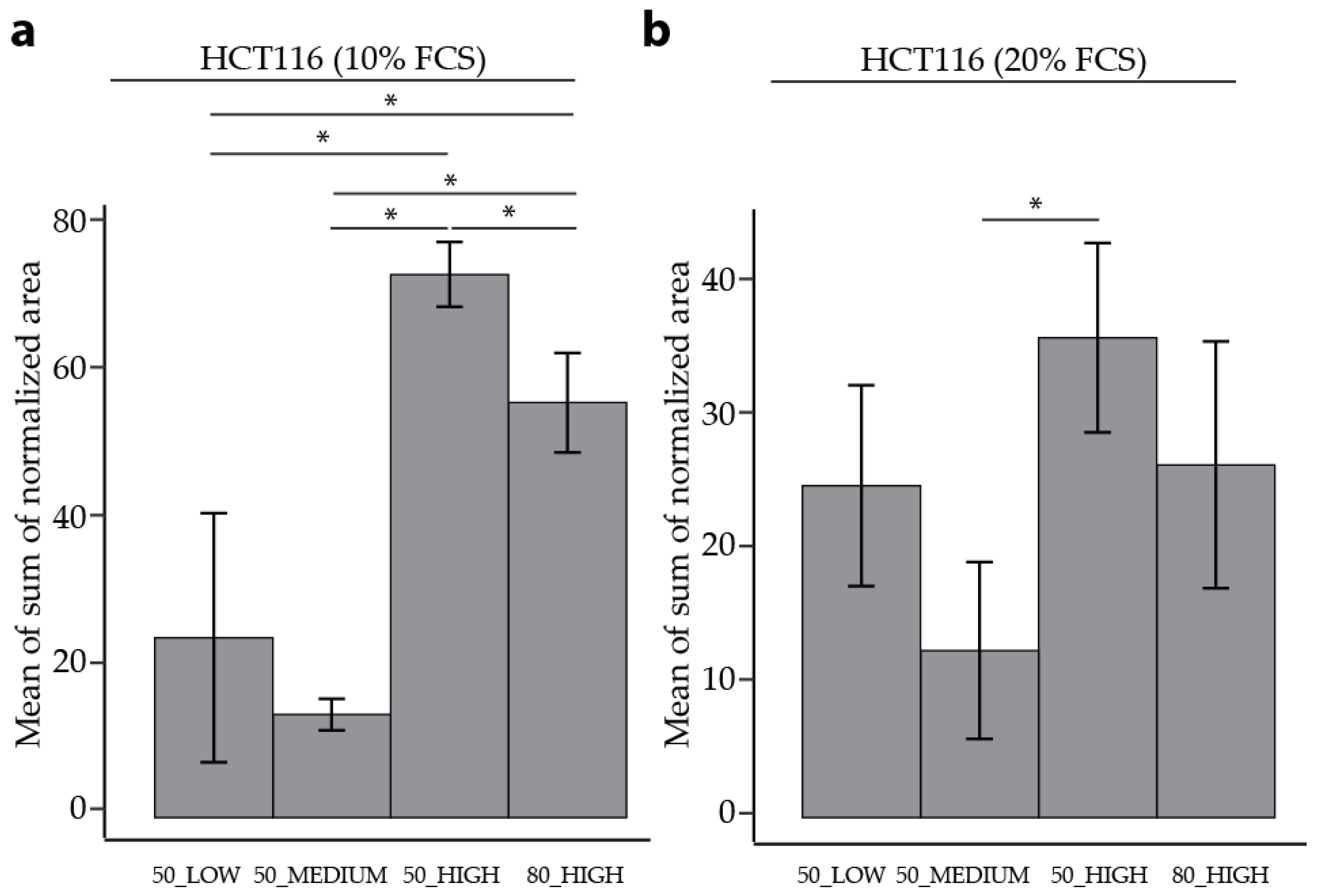Modified Protocol of Harvesting, Extraction, and Normalization Approaches for Gas Chromatography Mass Spectrometry-Based Metabolomics Analysis of Adherent Cells Grown Under High Fetal Calf Serum Conditions
Abstract
1. Introduction
2. Results
2.1. Preliminary Experiments on Phase Separation
2.2. Experiment 1: Determining the Optimum Concentration of MeOH as a Quenching and Extraction Solution for Cell Harvesting
2.3. Experiment 2: Determination of the Optimal Volume and Ratio of MeOH:CHCl3:H2O for a Metabolite Extraction Solution
2.4. Experiment 3: Total Protein versus Cell Mass as a Normalization Strategy
3. Discussion
4. Materials and Methods
4.1. Cell Culture
4.2. Experiment 1: Determination of the Optimum Concentration of Methanol as a Quenching and Extraction Solution for Cell Harvesting
4.3. Experiment 2: Determination of the Optimal Volume and Ratio of MeOH:CHCl3:H2O for a Metabolite Extraction Solution
4.4. Experiment 3: Total Protein versus Cell Mass as a Normalization Strategy
4.5. Protein Extraction and Determination
4.6. GC-MS Metabolomics Measurement of Key Central Carbon Pathway Metabolites
4.7. Data Analysis
Supplementary Materials
Author Contributions
Funding
Acknowledgments
Conflicts of Interest
References
- Kapoore, R.V.; Vaidyanathan, S. Towards quantitative mass spectrometry-based metabolomics in microbial and mammalian systems. Philos. Trans. A Math. Phys. Eng. Sci. 2016, 374. [Google Scholar] [CrossRef] [PubMed]
- Sellick, C.A.; Hansen, R.; Maqsood, A.R.; Dunn, W.B.; Stephens, G.M.; Goodacre, R.; Dickson, A.J. Effective quenching processes for physiologically valid metabolite profiling of suspension cultured Mammalian cells. Anal. Chem. 2009, 81, 174–183. [Google Scholar] [CrossRef] [PubMed]
- Sellick, C.A.; Hansen, R.; Stephens, G.M.; Goodacre, R.; Dickson, A.J. Metabolite extraction from suspension-cultured mammalian cells for global metabolite profiling. Nat. Protoc. 2011, 6, 1241–1249. [Google Scholar] [CrossRef]
- Bolten, C.J.; Kiefer, P.; Letisse, F.; Portais, J.C.; Wittmann, C. Sampling for metabolome analysis of microorganisms. Anal. Chem. 2007, 79, 3843–3849. [Google Scholar] [CrossRef]
- Dettmer, K.; Nurnberger, N.; Kaspar, H.; Gruber, M.A.; Almstetter, M.F.; Oefner, P.J. Metabolite extraction from adherently growing mammalian cells for metabolomics studies: Optimization of harvesting and extraction protocols. Anal. Bioanal. Chem. 2011, 399, 1127–1139. [Google Scholar] [CrossRef] [PubMed]
- Danielsson, A.P.; Moritz, T.; Mulder, H.; Spegel, P. Development and optimization of a metabolomic method for analysis of adherent cell cultures. Anal. Biochem. 2010, 404, 30–39. [Google Scholar] [CrossRef]
- Dietmair, S.; Timmins, N.E.; Gray, P.P.; Nielsen, L.K.; Kromer, J.O. Towards quantitative metabolomics of mammalian cells: Development of a metabolite extraction protocol. Anal. Biochem. 2010, 404, 155–164. [Google Scholar] [CrossRef]
- Lorenz, M.A.; Burant, C.F.; Kennedy, R.T. Reducing time and increasing sensitivity in sample preparation for adherent mammalian cell metabolomics. Anal. Chem. 2011, 83, 3406–3414. [Google Scholar] [CrossRef] [PubMed]
- Kuehnbaum, N.L.; Britz-McKibbin, P. New advances in separation science for metabolomics: Resolving chemical diversity in a post-genomic era. Chem. Rev. 2013, 113, 2437–2468. [Google Scholar] [CrossRef] [PubMed]
- Chrysanthopoulos, P.K.; Goudar, C.T.; Klapa, M.I. Metabolomics for high-resolution monitoring of the cellular physiological state in cell culture engineering. Metab. Eng. 2010, 12, 212–222. [Google Scholar] [CrossRef] [PubMed]
- Winder, C.L.; Dunn, W.B.; Schuler, S.; Broadhurst, D.; Jarvis, R.; Stephens, G.M.; Goodacre, R. Global metabolic profiling of Escherichia coli cultures: An evaluation of methods for quenching and extraction of intracellular metabolites. Anal. Chem. 2008, 80, 2939–2948. [Google Scholar] [CrossRef] [PubMed]
- Sapcariu, S.C.; Kanashova, T.; Weindl, D.; Ghelfi, J.; Dittmar, G.; Hiller, K. Simultaneous extraction of proteins and metabolites from cells in culture. MethodsX 2014, 1, 74–80. [Google Scholar] [CrossRef] [PubMed]
- Bligh, E.G.; Dyer, W.J. A rapid method of total lipid extraction and purification. Can. J. Biochem. Physiol. 1959, 37, 911–917. [Google Scholar] [CrossRef] [PubMed]
- Folch, J.; Ascoli, I.; Lees, M.; Meath, J.A.; Le, B.N. Preparation of lipide extracts from brain tissue. J. Biol. Chem. 1951, 191, 833–841. [Google Scholar] [PubMed]
- Folch, J.; Lees, M.; Stanley, G.H.S. A simple method for the isolation and purification of total lipides from animal tissues. J. Biol. Chem. 1957, 226, 497–509. [Google Scholar]
- Chaipinyo, K.; Oakes, B.W.; van Damme, M.P.I. Effects of growth factors on cell proliferation and matrix synthesis of low-density, primary bovine chondrocytes cultured in collagen I gels. J. Orthop. Res. 2002, 20, 1070–1078. [Google Scholar] [CrossRef]
- Lorenz, M.; Blaschke, B.; Benn, A.; Hammer, E.; Witt, E.; Kirwan, J.; Fritsche-Guenther, R.; Gloaguen, Y.; Bartsch, C.; Vietzke, A.; et al. Sex-specific metabolic and functional differences in human umbilical vein endothelial cells from twin pairs. Atherosclerosis 2019, 291, 99–106. [Google Scholar] [CrossRef]
- Gupta, R.K.; Irie, R.F.; Morton, D.L. Antigens on human tumor cells assayed by complement fixation with allogeneic sera. Cancer Res. 1978, 38, 2573–2580. [Google Scholar]
- Marin, V.; Kaplanski, G.; Gres, S.; Farnarier, C.; Bongrand, P. Endothelial cell culture: Protocol to obtain and cultivate human umbilical endothelial cells. J. Immunol. Methods 2001, 254, 183–190. [Google Scholar] [CrossRef]
- Rosner, D.; McCarthy, N.; Bennett, M. Rapamycin inhibits human in stent restenosis vascular smooth muscle cells independently of pRB phosphorylation and p53. Cardiovasc. Res. 2005, 66, 601–610. [Google Scholar] [CrossRef]
- Hinrichs, S.; Scherschel, K.; Kruger, S.; Neumann, J.T.; Schwarzl, M.; Yan, I.; Warnke, S.; Ojeda, F.M.; Zeller, T.; Karakas, M.; et al. Precursor proadrenomedullin influences cardiomyocyte survival and local inflammation related to myocardial infarction. Proc. Natl. Acad. Sci. USA 2018, 115, E8727–E8736. [Google Scholar] [CrossRef] [PubMed]
- Lang, S.; Herrmann, M.; Pfeifer, C.; Brockhoff, G.; Zellner, J.; Nerlich, M.; Angele, P.; Prantl, L.; Gehmert, S.; Loibl, M. Leukocyte-reduced platelet-rich plasma stimulates the in vitro proliferation of adipose-tissue derived mesenchymal stem cells depending on PDGF signaling. Clin. Hemorheol. Microcirc. 2017, 67, 183–196. [Google Scholar] [CrossRef] [PubMed]
- Pietzke, M.; Zasada, C.; Mudrich, S.; Kempa, S. Decoding the dynamics of cellular metabolism and the action of 3-bromopyruvate and 2-deoxyglucose using pulsed stable isotope-resolved metabolomics. Cancer Metab. 2014, 2, 9. [Google Scholar] [CrossRef] [PubMed]
- Fritsche-Guenther, R.; Zasada, C.; Mastrobuoni, G.; Royla, N.; Rainer, R.; Rossner, F.; Pietzke, M.; Klipp, E.; Sers, C.; Kempa, S. Alterations of mTOR signaling impact metabolic stress resistance in colorectal carcinomas with BRAF and KRAS mutations. Sci. Rep. 2018, 8, 9204. [Google Scholar] [CrossRef] [PubMed]
- Cao, B.; Aa, J.; Wang, G.; Wu, X.; Liu, L.; Li, M.; Shi, J.; Wang, X.; Zhao, C.; Zheng, T.; et al. GC-TOFMS analysis of metabolites in adherent MDCK cells and a novel strategy for identifying intracellular metabolic markers for use as cell amount indicators in data normalization. Anal. Bioanal. Chem. 2011, 400, 2983–2993. [Google Scholar] [CrossRef] [PubMed]
- Ritter, J.B.; Genzel, Y.; Reichl, U. Simultaneous extraction of several metabolites of energy metabolism and related substances in mammalian cells: Optimization using experimental design. Anal. Biochem. 2008, 373, 349–369. [Google Scholar] [CrossRef]
- Dunn, W.B.; Wilson, I.D.; Nicholls, A.W.; Broadhurst, D. The importance of experimental design and QC samples in large-scale and MS-driven untargeted metabolomic studies of humans. Bioanalysis 2012, 4, 2249–2264. [Google Scholar] [CrossRef]
- Bi, H.; Krausz, K.W.; Manna, S.K.; Li, F.; Johnson, C.H.; Gonzalez, F.J. Optimization of harvesting, extraction, and analytical protocols for UPLC-ESI-MS-based metabolomic analysis of adherent mammalian cancer cells. Anal. Bioanal. Chem. 2013, 405, 5279–5289. [Google Scholar] [CrossRef]
- Beckonert, O.; Keun, H.C.; Ebbels, T.M.; Bundy, J.; Holmes, E.; Lindon, J.C.; Nicholson, J.K. Metabolic profiling, metabolomic and metabonomic procedures for NMR spectroscopy of urine, plasma, serum and tissue extracts. Nat. Protoc. 2007, 2, 2692–2703. [Google Scholar] [CrossRef]
- Cuperlovic-Culf, M.; Barnett, D.A.; Culf, A.S.; Chute, I. Cell culture metabolomics: Applications and future directions. Drug Discov. Today 2010, 15, 610–621. [Google Scholar] [CrossRef]
- Matyash, V.; Liebisch, G.; Kurzchalia, T.V.; Shevchenko, A.; Schwudke, D. Lipid extraction by methyl-tert-butyl ether for high-throughput lipidomics. J. Lipid Res. 2008, 49, 1137–1146. [Google Scholar] [CrossRef] [PubMed]
- Muschet, C.; Moller, G.; Prehn, C.; de Angelis, M.H.; Adamski, J.; Tokarz, J. Removing the bottlenecks of cell culture metabolomics: Fast normalization procedure, correlation of metabolites to cell number, and impact of the cell harvesting method. Metabolomics 2016, 12, 151. [Google Scholar] [CrossRef] [PubMed]
- Blankenship, D.; Niemi, J.; Hilow, E.; Karl, M.; Sundararajan, S. Oral pioglitazone reduces infarction volume and improves neurologic function following MCAO in rats. Adv. Exp. Med. Biol. 2011, 701, 157–162. [Google Scholar] [CrossRef] [PubMed]



| Condition Name | 50_LOW | 50_MEDIUM | 50_HIGH | 80_HIGH |
|---|---|---|---|---|
| Biological replicates 10% FCS | 4 | 3 | 4 | 5 |
| Biological replicates 20% FCS | 5 | 3 | 4 | 4 |
| HCT116 (10% FCS) | 51 | 20 | 14 | 13 |
| HCT116 (20% FCS) | 30 | 42 | 16 | 8 |
| Condition Name | 50_LOW | 50_MEDIUM | 50_HIGH | 80_HIGH |
|---|---|---|---|---|
| Biological replicates 10% FCS | 4 | 3 | 4 | 5 |
| Biological replicates 20% FCS | 5 | 3 | 4 | 4 |
| HCT116 (10% FCS) | 68% | 22% | 14% | 23% |
| HCT116 (20% FCS) | 33% | 55% | 26% | 30% |
| Condition Name | 50_LOW | 50_MEDIUM | 50_HIGH | 80_HIGH |
|---|---|---|---|---|
| Biological replicates 10% FCS | 4 | 3 | 4 | 5 |
| Biological replicates 20% FCS | 5 | 3 | 4 | 4 |
| HCT116 (10% FCS) | 0% | 73% | 79% | 67% |
| HCT116 (20% FCS) | 15% | 3% | 73% | 53% |
| Condition Name | 50_LOW ( ) ) | 50_MEDIUM ( ) ) | 50_HIGH ( ) ) | 80_HIGH ( ) ) |
|---|---|---|---|---|
| 5 mL of MeOH harvest | 50% (2.5 + 2.5) * | 50% (2.5 + 2.5) * | 50% (2.5 + 2.5) * | 80% (4.0 + 1.0) * |
| MeOH [mL] for extraction | - | - | 1.5 | - |
| H2O [mL] for extraction | - | - | 1.5 | 3.0 |
| CHCl3 [mL] for extraction | 1.0 | 2.5 | 4.0 | 4.0 |
| Final volume [mL] | 6.0 | 7.5 | 12 | 12 |
| Final ratio v/v/v | 1:0.4:1 | 1:1:1 | 1:1:1 | 1:1:1 |
| Final polar volume [mL] | 5.0 | 5.0 | 8.0 | 8.0 |
| Used polar volume [mL] | 3.0 | 3.0 | 6.0 | 6.0 |
| Condition Name | 50_LOW | 50_MEDIUM | 50_HIGH | 80_HIGH |
|---|---|---|---|---|
| Biological replicates 10% FCS | 4 | 3 | 4 | 5 |
| Biological replicates 20% FCS | 5 | 3 | 4 | 4 |
| HCT116 (10% FCS) | 38/45 | 39/45 | 38/45 | 39/45 |
| HCT116 (20% FCS) | 41/45 | 41/45 | 40/45 | 40/45 |
| HCT116 (10% FCS) | HCT116 (20% FCS) | |||
|---|---|---|---|---|
| Cell Mass | Protein | Cell Mass | Protein | |
| Median RSD [%] | 28 | 24 | 25 | 35 |
| RSD < 30% [%] | 55 | 60 | 60 | 33 |
© 2019 by the authors. Licensee MDPI, Basel, Switzerland. This article is an open access article distributed under the terms and conditions of the Creative Commons Attribution (CC BY) license (http://creativecommons.org/licenses/by/4.0/).
Share and Cite
Fritsche-Guenther, R.; Bauer, A.; Gloaguen, Y.; Lorenz, M.; Kirwan, J.A. Modified Protocol of Harvesting, Extraction, and Normalization Approaches for Gas Chromatography Mass Spectrometry-Based Metabolomics Analysis of Adherent Cells Grown Under High Fetal Calf Serum Conditions. Metabolites 2020, 10, 2. https://doi.org/10.3390/metabo10010002
Fritsche-Guenther R, Bauer A, Gloaguen Y, Lorenz M, Kirwan JA. Modified Protocol of Harvesting, Extraction, and Normalization Approaches for Gas Chromatography Mass Spectrometry-Based Metabolomics Analysis of Adherent Cells Grown Under High Fetal Calf Serum Conditions. Metabolites. 2020; 10(1):2. https://doi.org/10.3390/metabo10010002
Chicago/Turabian StyleFritsche-Guenther, Raphaela, Anna Bauer, Yoann Gloaguen, Mario Lorenz, and Jennifer A. Kirwan. 2020. "Modified Protocol of Harvesting, Extraction, and Normalization Approaches for Gas Chromatography Mass Spectrometry-Based Metabolomics Analysis of Adherent Cells Grown Under High Fetal Calf Serum Conditions" Metabolites 10, no. 1: 2. https://doi.org/10.3390/metabo10010002
APA StyleFritsche-Guenther, R., Bauer, A., Gloaguen, Y., Lorenz, M., & Kirwan, J. A. (2020). Modified Protocol of Harvesting, Extraction, and Normalization Approaches for Gas Chromatography Mass Spectrometry-Based Metabolomics Analysis of Adherent Cells Grown Under High Fetal Calf Serum Conditions. Metabolites, 10(1), 2. https://doi.org/10.3390/metabo10010002





